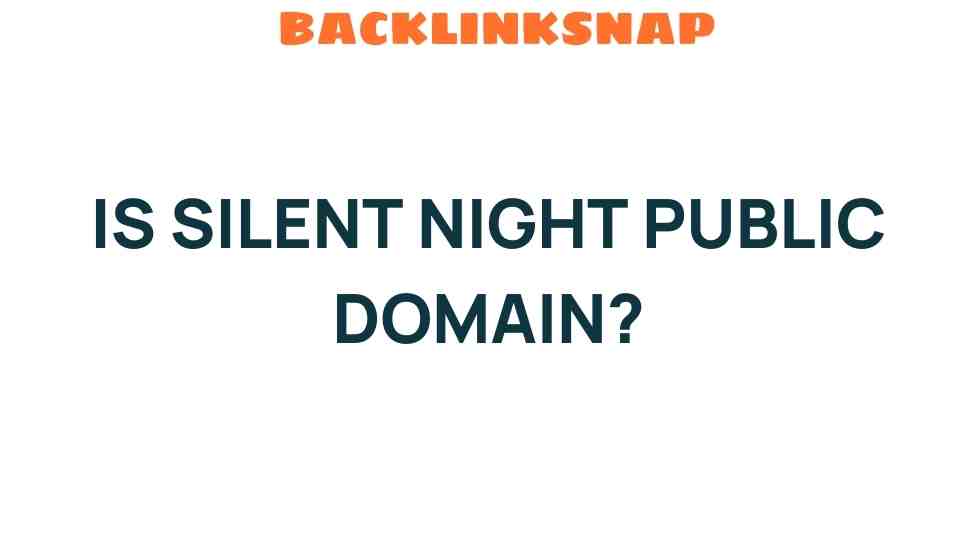Is Silent Night in the Public Domain? Uncovering the Truth Behind the Classic
As the holiday season approaches, the sweet, soothing melody of “Silent Night” fills the air, evoking feelings of warmth, nostalgia, and celebration. This beloved Christmas carol has become a staple in holiday traditions across the globe. However, amid its widespread popularity, a question often arises: Is “Silent Night” in the public domain? Understanding the copyright status of this cherished tune is essential for musicians, choirs, and anyone who wishes to incorporate it into their holiday festivities. In this article, we will explore the music history of “Silent Night,” its copyright status, and the cultural heritage it represents, while uncovering the legal implications surrounding its use.
The Origins of Silent Night
“Silent Night,” originally titled “Stille Nacht, heilige Nacht,” was composed in 1818 by Franz Xaver Gruber, with lyrics written by Joseph Mohr. The carol was first performed on Christmas Eve in a small church in Oberndorf, Austria. Legend has it that the church’s organ was broken, prompting Mohr to ask Gruber to compose a simple melody that could be sung with guitar accompaniment.
This humble beginning laid the groundwork for what would become one of the most recognizable Christmas carols in history. “Silent Night” was soon translated into several languages and spread across the world, captivating audiences with its serene message of peace and hope.
Understanding Public Domain
To determine whether “Silent Night” is in the public domain, we must first understand what public domain means. Works in the public domain are free for anyone to use, reproduce, and distribute without seeking permission or paying royalties. Generally, works enter the public domain after their copyright term expires, which varies by country. In the United States, for example, the copyright term is typically the life of the author plus 70 years.
Copyright Status of Silent Night
Given that “Silent Night” was composed in the early 19th century, it is indeed in the public domain. The song’s lyrics and melody, having been created over 100 years ago, are no longer under copyright protection. This means that anyone can freely perform, record, and adapt the song without obtaining permission or incurring legal ramifications.
However, it’s important to note that while the original composition is in the public domain, specific arrangements or adaptations of “Silent Night” may still be protected by copyright. For instance, a modern orchestration or a unique lyrical adaptation could still be under copyright, depending on when it was created and the applicable copyright laws. Therefore, if you’re planning to perform or record a version of “Silent Night,” it’s prudent to verify the copyright status of the specific arrangement you intend to use.
Cultural Heritage and Holiday Traditions
“Silent Night” holds a special place in the hearts of countless individuals and communities around the world. It has been translated into over 300 languages and is a central piece in various holiday traditions. From church services to family gatherings, its gentle melody and profound message resonate deeply during the Christmas season.
The song’s themes of peace, love, and tranquility provide a comforting backdrop to the hustle and bustle of holiday preparations. Many families have cherished memories of singing “Silent Night” together, often by candlelight, creating a sense of unity and connection that transcends generations.
Legal Implications for Performers and Creators
- Arrangements: If you wish to perform or record a specific arrangement, ensure that it is also in the public domain.
- Adaptations: If you create an adaptation of “Silent Night,” you might hold copyright over your version, so it’s essential to document your work.
- Performance Rights: Some venues may require performance licenses, even for public domain songs, so check local regulations.
By understanding these legal aspects, artists can confidently share this beautiful carol without fear of infringement.
FAQs About Silent Night and Public Domain
1. Is “Silent Night” copyrighted?
No, the original composition of “Silent Night” is in the public domain, meaning it can be used freely without copyright restrictions.
2. Can I create my own version of “Silent Night”?
Yes, you can create your own version of “Silent Night.” However, if you adapt it significantly, you may hold copyright over your version.
3. Are there any restrictions on performing “Silent Night”?
While the song itself is in the public domain, some venues may have policies regarding performance rights, so it’s best to check beforehand.
4. How many languages has “Silent Night” been translated into?
“Silent Night” has been translated into over 300 languages, showcasing its universal appeal and cultural significance.
5. Who composed “Silent Night”?
Franz Xaver Gruber composed the melody, while Joseph Mohr wrote the lyrics for “Silent Night.”
6. When was “Silent Night” first performed?
“Silent Night” was first performed on Christmas Eve in 1818 in Oberndorf, Austria.
Conclusion
As we delve into the enchanting world of Christmas carols, “Silent Night” emerges as a timeless classic deeply rooted in cultural heritage and holiday traditions. Its status as a public domain work allows it to be embraced and celebrated by people of all ages and backgrounds. Whether sung in a church, around a fireplace, or during festive gatherings, the song continues to resonate with the message of peace and love. As you prepare for the holiday season, consider incorporating “Silent Night” into your celebrations, knowing that this beautiful melody belongs to all and can be shared freely. For more information on copyright and public domain music, you can visit Cornell Law School to better understand your rights and responsibilities as a creator.
This article is in the category Digital Marketing and created by BacklinkSnap Team




